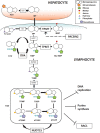Pharmacogenetics of thiopurines
- PMID: 35582727
- PMCID: PMC8992634
- DOI: 10.20517/cdr.2019.004
Pharmacogenetics of thiopurines
Abstract
Polychemotherapeutic protocols for the treatment of pediatric acute lymphoblastic leukemia (ALL) always include thiopurines. Specific approaches vary in terms of drugs, dosages and combinations. Such therapeutic schemes, including risk-adapted intensity, have been extremely successful for children with ALL who have reached an outstanding 5-year survival of greater than 90% in developed countries. Innovative drugs such as the proteasome inhibitor bortezomib and the bi-specific T cell engager blinatumomab are available to further improve therapeutic outcomes. Nevertheless, daily oral thiopurines remain the backbone maintenance or continuation therapy. Pharmacogenetics allows the personalization of thiopurine therapy in pediatric ALL and clinical guidelines to tailor therapy on the basis of genetic variants in TPMT and NUDT15 genes are already available. Other genes of interest, such as ITPA and PACSIN2, have been implicated in interindividual variability in thiopurines efficacy and adverse effects and need additional research to be implemented in clinical protocols. In this review we will discuss current literature and clinical guidelines available to implement pharmacogenetics for tailoring therapy with thiopurines in pediatric ALL.
Keywords: NUDT15; PACSIN2; Thiopurines; acute lymphoblastic leukemia; inosine triphosphate pyrophosphatase; pharmacogenetics clinical implementation; therapy personalization; thiopurine methyltransferase.
© The Author(s) 2019.
Conflict of interest statement
All authors declared that there are no conflicts of interest.
Figures


References
-
- Cara CJ, Pena AS, Sans M, Rodrigo L, Guerrero-Esteo M, et al. Reviewing the mechanism of action of thiopurine drugs: towards a new paradigm in clinical practice. Med Sci Monit. 2004;10:RA247–54. - PubMed
-
- Krenitsky TA, Papaioannou R, Elion GB. Human hypoxanthine phosphoribosyltransferase. I. Purification, properties, and specificity. J Biol Chem. 1969;244:1263–70. - PubMed
Publication types
LinkOut - more resources
Full Text Sources
Miscellaneous
